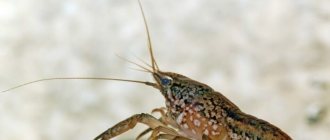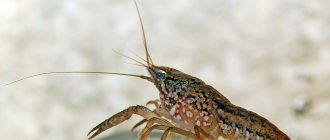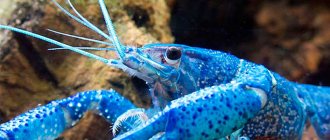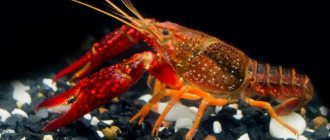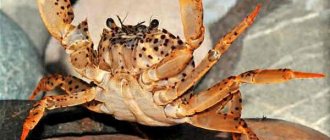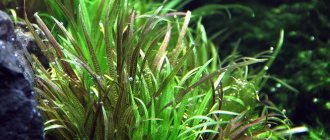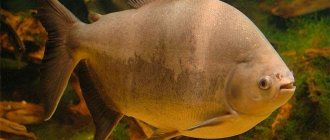Cancers
Simplicity of content:
Latin name: Procambarus cubensis
Lifespan: 3 years
Maximum size: 12 cm.
Average cost: 250 rub.
Sometimes even an experienced aquarist gets bored. The aquarium is not so bright, the plants are boring, and communication with the fish is not as exciting as it was before. Keeping some beautiful exotic animal in an aquarium is truly interesting! An excellent option is blue crayfish.
Description of the appearance of the Cuban crayfish
The Cuban crayfish (Procambarus cubensis), except for its bright blue or blue color, is no longer distinguished from ordinary representatives:
- Body and size . The body shape is typical - 10-13 cm (without claws), claw length - from 5 to 12 cm (in robust ones it can reach a length of 16-17 cm).
- Abdomen - consists of 7 lobes, and the last one ends with a five-lobed fan-shaped fin-tail.
- Claws . They use them to attack or fight enemies. Crayfish have antennae for touch and smell.
- Color . But cancer gets its bright color after 2 years of life, even if they reach sexual maturity after six months. Interestingly, the species can be not only blue-blue, but also beige, red-brown, yellow and indigo. The color depends on the “parents” - if the male and female are blue, then their offspring will inherit this color at the genetic level. The shade appeared as a result of genetic mutations, but the color of the cancer can change depending on the conditions under which it is kept.
- Movement. Like all crayfish, Cubans move slowly on 4 legs (from the bottom of the cephalothorax), with their claws pointed forward.
Males among females are distinguished by their voluminous claws and gonopodium, which is responsible for fertilization (an organ is formed from 2 frontal pairs of abdominal swimming legs).
Cubans usually live in an aquarium for about 3 years.
Let's get acquainted
This freshwater crustacean belongs to the order Decapods. In nature, blue Cuban crayfish, as the name suggests, live in Cuba, and they came to us relatively recently - in the 80s of the last century. This arthropod withstands fierce competition with other similar creatures, of which there are many available in markets and stores.
Cuban crayfish have a capricious character. If there are a lot of them in the aquarium, then the males begin to boldly fight for the females. They raise and spread their claws, thus intimidating their rivals. They also try to catch small fish, but most often without success, although sometimes they are lucky. But this drawback can be forgiven, since crayfish are aquarium orderlies, eating leftover food, dead parts of algae and dead fish. But this does not mean that crayfish do not need to be fed at all. Cuban crayfish reproduce well, and many aquarists have turned this advantage into an additional source of income.
Shedding
Blue crayfish, just like all others, shed their shells in due course, but young ones molt more often than adults. Molting occurs gradually:
- the shell bursts along the entire back;
- the individual crawls out from under the old skin and claws;
- the cover is similar to a living crayfish with claws and antennae, only the shell becomes transparent;
- cancer, which has become defenseless for a while, eats up its dropped defenses in 2-3 days;
- in 3 days a new hardened shell is formed.
The time when the animal is left without protection is the most dangerous for it - the Cuban is now an easy prey for its fellow fish, large carp or cichlid fish. Therefore, during the molting period, it is better to remove the crayfish and feed them well.
Compatibility with fish
When the blue crayfish's defenses are strong and reliable, in the aquarium it gets along well with all fish, except predatory ones. By itself, he is quite peaceful. They calmly coexist with catfish or cichlids. But you shouldn’t let Cubans live with:
- small fish - neon and guppies;
- veiled - the tail attracts crayfish.
To avoid eating the bluest beauty, you should not place him next to large predators:
- arowana;
- tetradons;
- water turtles.
It is worth considering that if you put two males in one aquarium, they will constantly divide the territory, and the fights will be fierce.
Benefits and harms
Most people dream of getting a blue Cuban crayfish to improve their aquarium. This cancer is bright, large and spectacular.
What are the benefits of arthropods:
- eats up the leftover food from the fish, so it is a kind of aquarium cleaner;
- feeds on dead organic matter (eats the remains of dead fish that the aquarist did not catch in time);
- It looks effective and decorates with its bright color.
Damage from the Cuban:
- the predator often eats bottom or sleeping fish (catfish, neon, guppies);
- is a carrier of some diseases, for example, mycosis.
- digs up plants and tramples moss.
The blue Cuban crayfish is a bright and distinctive pet!
Even a novice aquarium enthusiast will be able to keep and breed blue crayfish at home. The Cuban stands out for its activity and bright color. If all recommendations are followed, it will live up to three years.
The necessary conditions
For the normal development of Cubans, it is recommended to create the necessary conditions:
- Choosing an aquarium . One blue crayfish requires at least 20-23 liters of water. If there are several individuals, the size of the artificial tank increases depending on the quantity: for 2 adults - about 50 liters, for 4 - at least 100 liters, etc. It is advisable to completely fill the aquarium with water (leaving 3-5 cm at the top) and close the lid on top, since the cancer can escape.
- Soil . In an aquarium with Cuban crayfish, it is better to sprinkle the bottom with sand and limestone chips. Individuals love to dig in the ground, so all existing massive stones are removed from the bottom.
- Aeration . The container should be equipped with an aerator (but hang it so that the crayfish cannot reach the wires).
- Vegetation . It is recommended to plant hard-leaved vegetation (Thailand fern or cryptocoryne are suitable). He will gnaw off all the soft leaves in the shortest possible time.
- Water parameters . The water in the aquarium must be clean and transparent, rich in oxygen and meet the preferences of the crayfish: temperature - from +23°C, hardness - from 7 to 12 units. (necessary for the formation of a strong shell), acidity - from 5.1 to 7.6 pH, nitrates - no higher than 100 mg/l (high levels will destroy crayfish). Change of water - once every 7-8 days in a volume of 1/4 of the entire aquarium.
- Lighting . Daylight hours are from 12 hours in hot months and at least 10 hours in cold months.
Where does it live?
Based on the name, it’s easy to guess where crayfish come from. They live in small bodies of water on the island of Cuba, which is located in the northern Caribbean Sea. Mostly freshwater animals live in small bodies of warm water (streams, ponds or lakes).
Crayfish live in small bodies of warm water
Note! Cuban crayfish love to hide in various types of shelters , for example, under snags, tree roots or small stones.
Feeding
Cubans are omnivorous and unpretentious in their diet. They can buy live and plant food:
- lean fish, meat or squid, cut into pieces;
- any raw vegetables;
- dry food intended for fish;
- bloodworms, larvae, snails, mini-frogs, earthworms, daphnia;
- aquatic vegetation with soft leaves;
- fallen leaves.
The main thing is to change the type of food daily and combine it so that the crayfish eat fully and develop well.
Basic content rules
Cancers love space. There should be about 20 liters of water per individual. Based on this calculation, a 100-liter aquarium is suitable for stocking with five specimens. However, what is much more important is not the volume of water, but the area of the bottom. The wider it is, the more comfortable your crayfish will feel. Some keep them in wide and low aquariums.
The soil is usually quartz sand, spread in a thick layer. If you cannot find such material, replace it with fine-grained pebbles. So that crayfish can hide, install various shelters at the bottom in which your pets will endure molting. In addition, shelters will reduce the number of fights between males. All kinds of grottoes, which can be purchased at any specialized store, pieces of medium-diameter plastic pipes, halves of coconut peel, and small ceramic pots with a wide neck are suitable.
Place the snags in such a way that their ends rise above the water, since crayfish love to breathe fresh air.
Reproduction of blue crayfish
Cuban crayfish are also undemanding during the breeding season. When they reach sexual maturity, the female and male are placed in the same aquarium. The male, in order to fertilize his partner, turns her over on his back. After mating (which sometimes lasts more than an hour), everything repeats.
Then the female lays up to 200 black eggs, which adhere to the mother’s abdominal legs. Immediately after mating and fertilization, it is advisable to separate the female from the male and other individuals. Over time, the eggs become lighter and you can even see the eyes of the crustaceans (black dots). If the eggs are unfertilized, they remain pinkish in color.
For 50 small babies you will need 60 liters of water.
Caring for offspring. After hatching, the crustaceans cling to the mother’s legs for about 7 days, and after they detach, the female is removed, since now they can develop on their own. Babies are fed the same as adults, only in crushed form. Crayfish molt weekly, and after six months - monthly. A bluish or other tint may be noticed after shedding. The water in an aquarium with a “kindergarten” needs to be changed by ¼ every day, but added to the water that has settled in an open container.
Breeding
Blue crayfish in an aquarium can produce offspring all year round. For breeding, an aquaterrarium with a volume of 20 liters per male and female, with a water temperature of 23-25 degrees, is suitable. There should be no soil, only small shell rock, grottoes, and aeration is also necessary. Every 4 days the water should be renewed, a quarter of the time. The female bearing the eggs is transplanted into a separate aquarium. The eggs ripen for three weeks. Small baby crustaceans will sit on the female for several more days. The water with the babies is renewed daily in the same proportions as in the breeding aquarium. The water should be crystal clear and fresh, without impurities from chlorine and nitrates.
Starter food for young animals - cyclops, daphnia, brine shrimp, chopped bloodworms and tubifex. Later, you can add gammarus and blue whiting fillets to the diet. For 50 small crustaceans, a tank with a volume of up to 100 liters is required. Young animals molt once a week, later - once every 1 month.
Diseases
Poor conditions, contaminated food and newcomers can kill the Blue Cuban. Therefore, it is advisable to place all new fish in a “quarantine” aquarium for several days before moving into a common aquarium and observe whether strange spots appear on the shell, how active they are and whether they eat with pleasure. Frequent diseases of Cubans:
- Porcelain disease and cancer plague , unfortunately, cannot be cured, but healthy individuals can be protected. If the abdomen turns white, you need to act immediately so as not to infect others. The detonator is a fungus that attacks the abdominal muscles and limbs. Transmitted from sick individuals.
- Burn disease is characterized by the appearance of dark brown or black spots on the shell and legs. Treat with fallen oak or alder leaves in the form of lotions. If the disease is treated too late, the cancer dies.
- of parasites (small yellowish-white leeches) that love to settle on the shell of the blue crayfish or its gills by placing the patient in slightly salted water.
Water saturated with nitrates can also kill Cubans - this indicator needs to be monitored more closely. To make the container with crayfish look more impressive, you should stick snow-white paper behind it and then admire the aquarium pets, standing out in all their glory.

